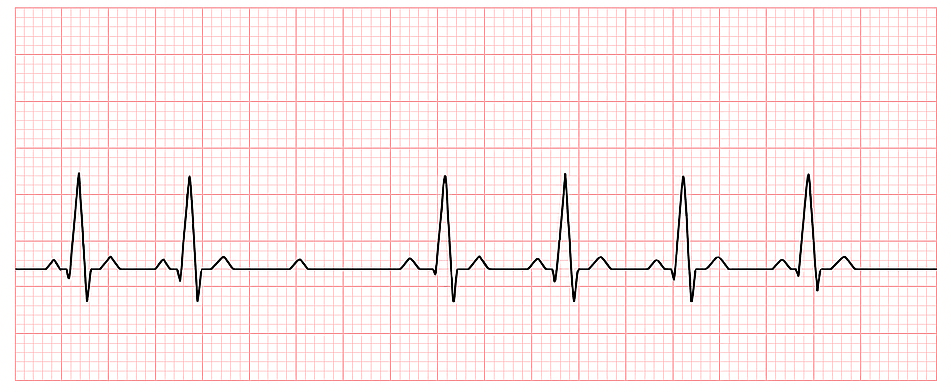Identify the telemetry strip below.

Third-degree AV block.
First-degree AV block.
Second-degree AV block Mobitz type 1 (Wenckebach).
Second-degree AV block Mobitz type 2.
The Correct Answer is C
Choice A rationale
Third-degree AV block, also known as complete heart block, is characterized by a complete dissociation between atrial and ventricular activity, meaning P waves and QRS complexes occur independently without any consistent relationship. This rhythm does not exhibit such complete dissociation.
Choice B rationale
First-degree AV block is indicated by a prolonged PR interval (greater than 0.20 seconds) with every P wave followed by a QRS complex. The rhythm strip shows a progressive lengthening of the PR interval before a dropped QRS, which is not characteristic of first-degree block.
Choice C rationale
Second-degree AV block Mobitz type 1 (Wenckebach) is characterized by a progressive lengthening of the PR interval over several beats, eventually culminating in a P wave that is not followed by a QRS complex (a dropped beat), after which the cycle repeats. This is exactly what is shown in the telemetry strip.
Choice D rationale
Second-degree AV block Mobitz type 2 is characterized by a constant PR interval for conducted beats, but with intermittent dropped QRS complexes without prior PR interval prolongation. This differs from the progressive PR lengthening seen in the provided rhythm strip.
Nursing Test Bank
Naxlex Comprehensive Predictor Exams
Related Questions
Correct Answer is D
Explanation
Choice A rationale
A ventricular pacemaker is designed to pace the ventricles, not the atria. Therefore, a pacemaker spike appearing before each P wave would indicate atrial pacing, which is not the primary function of a ventricular pacemaker. P waves represent atrial depolarization, and a ventricular pacemaker's stimulus is delivered to the ventricles to initiate a QRS complex.
Choice B rationale
A pacemaker spike appearing after each QRS complex suggests either oversensing, undersensing with competitive rhythms, or a malfunction. The purpose of a pacemaker spike is to *initiate* depolarization, not to follow it. If the spike occurs after the QRS, it indicates that the ventricle has already depolarized, and the spike is not contributing to ventricular contraction.
Choice C rationale
A pacemaker spike appearing with each T wave would be inappropriate and potentially dangerous. The T wave represents ventricular repolarization, a vulnerable period during which an electrical stimulus can induce life-threatening arrhythmias like ventricular fibrillation (R-on-T phenomenon). Pacing should occur before ventricular depolarization, not during repolarization.
Choice D rationale
A ventricular pacemaker functions by delivering an electrical impulse to the ventricle when its intrinsic rate falls below a programmed threshold. This impulse, seen as a pacemaker spike on the ECG, should precede ventricular depolarization, thus initiating a QRS complex. This indicates that the pacemaker is effectively stimulating ventricular contraction at the appropriate time.
Correct Answer is C
Explanation
Choice A rationale
A blood pressure of 124/79 mm Hg is not within the expected reference range for normotension. The expected reference range for normal blood pressure is typically defined as systolic blood pressure less than 120 mm Hg AND diastolic blood pressure less than 80 mm Hg, reflecting optimal cardiovascular health and minimal risk.
Choice B rationale
Stage 1 hypertension is defined by a systolic blood pressure between 130-139 mm Hg OR a diastolic blood pressure between 80-89 mm Hg. The client's blood pressure of 124/79 mm Hg does not meet these criteria, as both values are below the threshold for stage 1 hypertension.
Choice C rationale
A blood pressure of 124/79 mm Hg falls into the category of "elevated blood pressure.”. This classification is defined by a systolic blood pressure between 120-129 mm Hg AND a diastolic blood pressure less than 80 mm Hg, indicating a higher risk for developing hypertension.
Choice D rationale
Stage 2 hypertension is characterized by a systolic blood pressure of 140 mm Hg or higher OR a diastolic blood pressure of 90 mm Hg or higher. The client's blood pressure of 124/79 mm Hg is significantly below these thresholds, thus ruling out a diagnosis of stage 2 hypertension.
Whether you are a student looking to ace your exams or a practicing nurse seeking to enhance your expertise , our nursing education contents will empower you with the confidence and competence to make a difference in the lives of patients and become a respected leader in the healthcare field.
Visit Naxlex, invest in your future and unlock endless possibilities with our unparalleled nursing education contents today
Report Wrong Answer on the Current Question
Do you disagree with the answer? If yes, what is your expected answer? Explain.
Kindly be descriptive with the issue you are facing.
